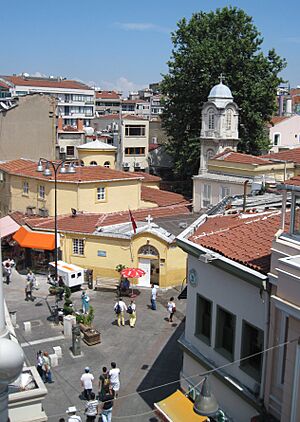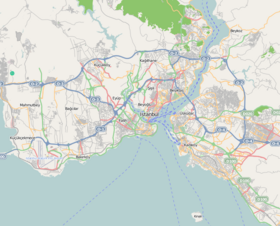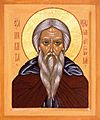Chalcedon facts for kids
Quick facts for kids
Chalcedon
Χαλκηδών
|
|
|---|---|
|
Town
|
|

The small Church of St Euphemia that serves as the Greek Orthodox cathedral of the Metropolitan Diocese
|
|
| Etymology: Carthage | |
|
Bithynia as a province of the Roman Empire, 120 AD
|
|
| Country | Bithynia |
Chalcedon (pronounced Kal-see-don) was an ancient port city in a region called Bithynia, in what is now Turkey. It was located right across from Byzantium, which later became Constantinople and is now Istanbul. Today, Chalcedon is a part of Istanbul called Kadıköy.
The name Chalcedon comes from a Phoenician word meaning "New Town." You might also know the mineral chalcedony, which was named after this city! Not many old buildings from Chalcedon are left today. But you can see ancient items found there at the Istanbul Archaeological Museum.
Contents
Discovering Ancient Chalcedon
Chalcedon was built on a small piece of land sticking out into the Sea of Marmara. This area is near the entrance to the Bosphorus strait. A small stream, called Kurbağalıdere today, flows into a nearby bay.
Early Settlers and the "Blind City"
Greek settlers from Megara (a city in Greece) founded Chalcedon around 685 BC. This was about 17 years before they founded Byzantium, the city across the water. People in ancient times thought the founders of Chalcedon must have been "blind." This is because the spot they chose was not as good as the land across the Bosphorus.
An ancient story says that the oracle of Apollo told the settlers to build their city "opposite to the blind." They believed "the blind" referred to Chalcedon. Even so, Chalcedon became a busy trading city. It had many temples, including one for the god Apollo.
Chalcedon's Territory
The land around Chalcedon, called Chalcedonia, stretched along the coast. It included important villages like Chrysopolis (modern Üsküdar) and Panteicheion (Pendik). Ancient writers even mentioned a spring in Chalcedonia that had small crocodiles!
Chalcedon Through the Ages
Chalcedon's history was often linked to Byzantium. It was captured by the Persians in the 6th century BC. The city often switched sides between the Spartans and the Athenians.
Under Roman Rule
Later, Chalcedon became part of the kingdom of Bithynia. The king of Bithynia gave his kingdom to the Roman Empire in 74 BC. Chalcedon was partly destroyed by Mithridates, a powerful king who fought against Rome. Thousands of Romans were killed during his attack on the city.
During the Roman Empire, Chalcedon recovered and was given special status as a free city. However, it was attacked many times by groups of barbarians. These groups crossed over after attacking Byzantium.
Byzantine and Ottoman Times
Chalcedon was very close to Constantinople, the new capital of the Byzantine Empire. Because of this, its stones were often used to build grand structures in Constantinople. Chalcedon was also frequently attacked by armies coming from the east.
In 361 AD, a special court was held in Chalcedon by Emperor Julian the Apostate. In 451 AD, a very important meeting of Christian leaders, called the Council of Chalcedon, took place here.
Chalcedon was badly damaged during the Fourth Crusade in 1204. It finally came under the rule of the Ottoman Empire about a century before the Ottomans conquered Constantinople itself.
Religious Importance
Chalcedon was an important Christian center from early times. Many Christian martyrs (people who died for their faith) are connected to Chalcedon. One famous martyr was St. Euphemia, and the main church in Chalcedon was named after her.
The Council of Chalcedon
The Fourth Ecumenical Council (a major meeting of Christian leaders) was held in Chalcedon in 451 AD. This council was very important because it discussed the nature of Jesus. It helped define that Jesus was both fully human and fully divine. This council led to some disagreements and a split with certain Christian churches, known as Oriental Orthodoxy.
After this council, Chalcedon became a "metropolitan see," which means it was a very important center for the church. The Greek Orthodox leader of Chalcedon still holds a high rank today within the church.
Famous People from Chalcedon
Many notable people came from ancient Chalcedon:
- Euphemia (3rd century AD): A Christian saint and martyr, she is the patron saint of Chalcedon.
- Boethus of Chalcedon (2nd century BC): A talented Greek sculptor.
- Herophilos (2nd century BC): A famous Greek physician.
- Phaleas of Chalcedon (4th century BC): A Greek statesman.
- Thrasymachus (5th century BC): A Greek philosopher known for his ideas on justice.
- Xenocrates (4th century BC): A Greek philosopher who led the Platonic Academy.
Images for kids
-
Funerary stele from the 1st century BC
-
Small silver jug from Chalcedon
See also
 In Spanish: Calcedonia (ciudad) para niños
In Spanish: Calcedonia (ciudad) para niños
- List of ancient Greek cities
- List of traditional Greek place names
- Chalkidona, Greece





